TABLE OF CONTENTS
Do you know how to tell if weed is good? Can you tell good weed from bad weed? If you are a regular user, you know how to spot bad-quality weed from a mile away. But beginners will need some guidance on how to avoid low-quality weed and buy good quality buds.
High-quality marijuana buds are not hard to come by. If you want to get the most bang out of your buck, check out our guide on weed quality to buy potent cannabis that smells, looks, and tastes great. Here is how you can tell good weed from bad.
Low-Shelf vs. Mid-Shelf vs. Top-Shelf Weed
Dispensaries make buying quality cannabis easy and simple by categorizing its weed in terms of quality. All weed sold at licensed dispensaries will be quality, but some strains will be better than others. Generally, dispensaries organize weed by low, mid, or top-shelf quality.
Low Shelf
Low-shelf cannabis products are the lowest in quality and price. While not bad weed, low-shelf may have lower cannabinoid concentrations. Low-shelf cannabis may consist of dried and cured trim or shake.
Mid-Shelf
Mid-shelf weed, traditionally displayed between the low and top-shelf, is the most popular option. Mid-shelf weed offers users a great value of quality cannabis at an affordable price.
Top-Shelf
Top-shelf weed, also known as dank weed, is the highest quality cannabis available at dispensaries. Top-shelf weed has the highest cannabinoid concentrations. It smells and tastes great and has a vibrant color.
Private Reserve
In some dispensaries, you may find a private reserve shelf for the connoisseur-grade weed. These exotic cannabis strains are grown under the best cultivation practices from the industry’s top growers.
How to Tell if Weed is Good
How easy is it to determine quality weed from bad weed? Consider the following factors when assessing weed quality.
Aroma and Flavor
Aroma and flavor are some of the best indicators of good or bad weed. Good weed is supposed to have a rich and complex smell and taste. Quality buds are grown, dried, and cured to have a high concentration of terpenes, their aromatic compounds.
Cannabis strains vary in smell and taste. Common notes found in good weed include pine, skunk, fuel, fruit, flowers, and much more. Some strains might have a more subtle but bright aromas while others may have strong and pungent ones.
Appearance
Good weed often has a striking and colorful appearance, known as “bag appeal.” Most cannabis strains display vivid green shades with rusty-colored pistil hairs. Some strains may produce various colors such as purple, blue, pink, and more, depending on their genetics and growing environment.
One of the most important factors to consider when buying cannabis flower buds is their trichome density and quality. Its trichomes are the small and resinous glands that glisten over the cannabis buds.
It is in these trichomes that cannabis produces cannabinoids, terpenes, flavonoids, and other essential oils. A higher concentration of trichomes correlates with stronger effects and a better flavor and aroma.
In terms of the trichome color, clear trichomes have a lower potency. As the trichomes mature, they turn a milky white and then a golden yellow color at their peak maturity. When about half of the buds' trichomes are amber, it is the perfect time to harvest.
If necessary, a magnifying glass can help you assess the quality of the trichomes. Dispensaries with magnifying capabilities on their bud jars can help you determine the bud quality.
Touch
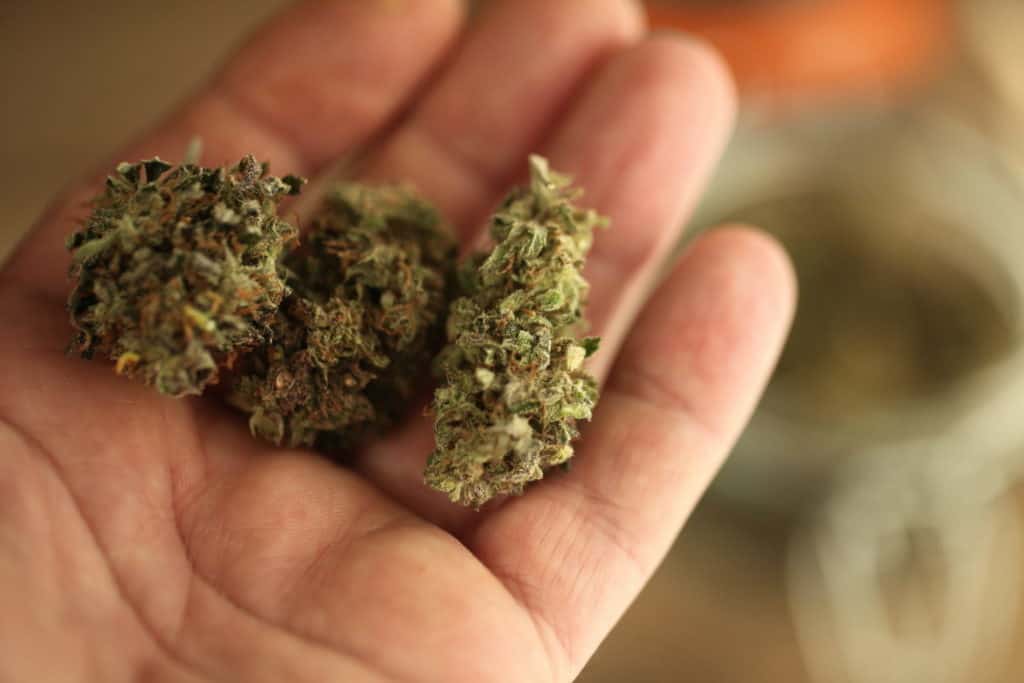
Cannabis consistency and texture are related to its quality. Good weed has a slightly sticky and dense feel due to its heavy resin content. Good weed must be easy to break down with your hands and should not feel dry or brittle. It should not be too soft or wet since this environment can increase the risk of mold and mildew formation.
Structure
Generally, quality sativa buds are fluffy and light, while indica buds tend to be dense and chunky. Hybrid strains have characteristics of sativa and indica genetics. Extra-firm or very wispy flower buds can indicate improper growing practices.
Other Factors to Consider When Buying Weed
Buying good weed requires more than just assessing its qualities with your senses. Consider its cultivation practices, chemical profile, price, and how dispensaries handle the product. All of these factors contribute to its overall quality.
Cultivation Practices
Organic and sustainable cultivation practices eliminate the need for synthetic fertilizers and are better for the environment. Look for organic cannabis with a Certified Kind and Clean Green label.
Cost
Generally, a higher cost is associated with top-shelf weed compared to low-quality weed. However, you can get a good deal by buying relatively lower quality weed, such as shake, with a high cannabinoid and terpene content, for an affordable price.
Chemical Profile
What cannabinoids and terpenes are in your strain? Consult the product’s certificate of analysis for its cannabinoid content. Most products do not list their terpene content.
Retail Practices
How do the budtenders handle the cannabis material? Cannabis budtenders must handle the buds carefully to avoid destroying their trichomes. We recommend buying from dispensaries that use tongs, chopsticks, or a similar device to carefully handle weed.
How Do You Know If You Have Bad Weed?
Bad weed, also known as reggie weed and dirt weed, is easy to spot once you know what good weed looks like. Essentially, dry, brittle, and odorless cannabis buds are considered low quality. Here is how you can tell if you have quality weed or not.
Aroma and Flavor
If your buds have a musty or hay-like aroma, they are low quality. Cannabis buds with a moldy aroma can indicate mold formation and be harmful if consumed. Bad aromas and flavors can also be due to improper drying and curing or aged cannabis.
Appearance
What does bad weed look like? Bad weed can have a dull color with a high concentration of stems and seeds. Look for trichome density and color. If your weed has a low trichome density with a majority of amber-colored trichomes, you have bad weed.
Touch
Bad weed can feel dry and brittle or soft and moist. Dry weed will feel extremely light unlike top-shelf weed, which is dense and sticky. Soft and wet nugs can lead to mold formation. “Shake” refers to sugar leaf trim that has a lower concentration of trichomes than flower buds.
Structure
Poor bud structure is instantly noticeable. Cannabis buds can be too fluffy or firm, indicating poor growing practices. Airy buds can be caused by inefficient lighting during the flowering stage.
How Long Does Weed Last?
Keeping your weed fresh for a long time is easy if you follow these best storage practices. Although weed can last for months without a significant loss in potency, weed can go bad fast if you're not careful.
Our guide gives you the 411 on how long properly stored weed can last, factors that affect the quality of your bud, the signs of bad weed, and tips for storing weed and keeping it fresh for longer.
How Long Does Weed Stay Good For?
Many cannabis users search online for “how long is weed good for?” Under the best storage conditions, the typical cannabis shelf life ranges from six months to one year.
Of course, this depends on many factors, including the product type, storage location, and other factors.
Does Weed Lose Potency?
Weed potency can go down over time. For example, one study found that weed loses 16% of its THC potency in one year, 26% in two years, 34% in three years, and 41% after four years of storage.
Can Weed Get Old?
A fresh nug with a strong aroma, flavor, and potency can turn old over time into a dry, odorless, and low-potency flower. While it may not provide the best smoking experience, old weed may still be good to consume.
Can Weed Go Bad?
We know weed can get old, but can it go bad? Yes, weed can turn ugly if you're not careful. Storing weed in areas with excessive humidity could lead to mold, which can be harmful if consumed.
Do not smoke moldy weed. Otherwise, old and low potency weed would taste harsh and not give you the best experience.
How to Tell if Weed Has Gone Bad
Is your weed still good to use? We've all been there. You find an old nug and don't know if it's good or not. It’s definitely not fresh weed, but is it bad? Here are some signs that your weed has gone bad.
Mold
Consuming moldy weed is not good. Mold can develop in environments that are too humid. Mold can have a white or gray powdery look and smell musty.
Texture
How your cannabis feels in your hands can tell you a lot about its quality. If it's too wet and spongy, it has a higher risk of mold. If it's too dry and crumbles in your fingers, you know it's lost a lot of its potency and may be a harsh smoke.
Aroma
Weed is supposed to have a pleasant aroma, whether fruity, sweet, earthy, or skunky. If it smells musty, do not consume it. It likely has mold.
What Affects Cannabis Quality
Knowing the factors that can affect how long weed stays good is essential. Cannabis growers spend months vegetating and flowering the plants to produce dense and pungent cannabis buds with tons of trichomes.
Trichomes are oils on the small outgrowths primarily found on the plant’s buds that contain cannabinoids, terpenes, and more.
Trichomes can be especially vulnerable to environmental factors such as heat, light, and humidity.
Humidity
Excessive humidity can wreak havoc on your buds, creating the perfect breeding ground for mold and bacteria. But too little humidity can also hurt by drying out your nugs.
Under optimal conditions, cannabis buds should remain between 54% and 63% relative humidity.
Light
Whether artificial or natural, light exposure can speed up the natural cannabinoid degradation process, leaving you with a weaker product.
Temperature
Excessively cold or hot temperatures can negatively affect cannabis. Freezing temperatures can make the trichomes brittle and likely to break off, while blazing hot temperatures can lower dry out the bud.
How to Store Weed
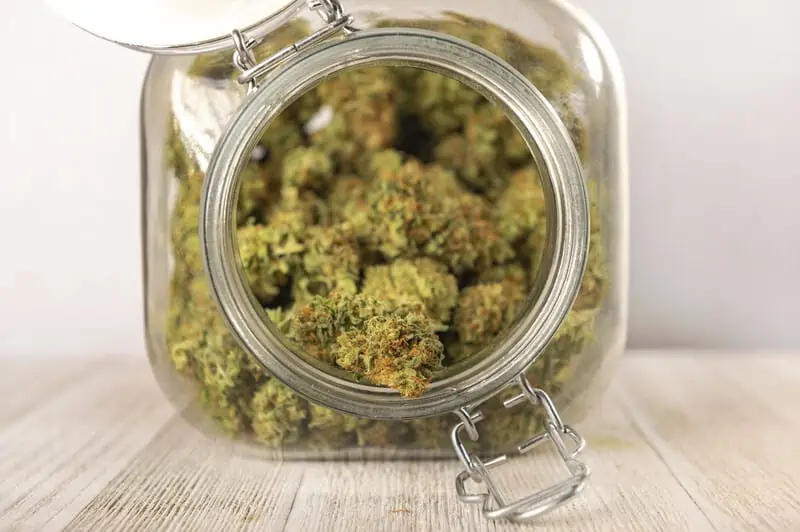
Now that you know how cannabis quality can be affected, it's time to protect your cannabis products with the proper storage practices. When stored properly, you can keep your weed potent for longer.
There are many ways to practice good weed storage, whether it's a simple glass jar or smell-proof stash boxes. Here is the best way to store weed for each product type and help it stay fresh.
Flower
Like all cannabis, cannabis flower potency is affected by air, light, and humidity. Keep your buds in an airtight, lightproof glass container and store them in a cool, dry, and dark location. Specialized cannabis humidors and humidity packs can help you control humidity.
Many people ask how long does weed stay good in a Ziploc bag? It can remain good for many weeks, depending on how you handle and store it. Plastic bags have a static charge that can attract the bud’s trichomes.
Edibles
Edibles such as cannabis-infused brownies, cookies, and gummies should be kept in their original packaging and stored in a cool, dry, and dark place. Gummies and hard candies may be more prone to heat damage than other edibles like baked goods.
Concentrates
Cannabis concentrate can be stored in glass or silicone containers. Vape cartridges containing cannabis oil should be stored in a dry, dark, and cold place and kept upright to prevent oil from spilling.
Many people search online for “how long does weed carts stay good?” In optimal storage conditions, vape cartridges can be good for 6 months to one year.
How Long Does Cannabis Stay Good? Summary
For people who use marijuana, the shelf life, freshness, and knowing when to discard it are all crucial factors to take into account.
How Long Does Weed Stay Fresh?
If stored correctly, weed can last anywhere from six months to a year. The efficacy of cannabinoids, such as THC and CBD, may diminish with time due to a decrease in their strength.
Affecting Factors for Shelf Life Of Weed
-Cannabinoids can be weakened by exposure to light.
-High temperatures have the potential to dry out weeds and encourage the growth of germs and mildew.
-While too little humidity will dry things out, too much humidity can lead to mold growth.
-Over time, oxygen can break down cannabinoids.
How to Determine Whether Weed Is Good
-Look for any signs of mildew or mold, which are typically white, fuzzy patches.
-There's a strong, unique smell to fresh cannabis. It might not be good if it has a moldy, musty, or just weird scent.
-Low quality is indicated if it is excessively moist and doesn't burn properly, or if it is too dry and crumbles readily.
-If it tastes harsh or off after smoking, it's probably beyond its best.
Preventing Weed From Going Bad and Extending Its Duration
-Keep out of direct sunlight and heat. Keep in an airtight container.
-To keep the ideal humidity level (typically about 62%), use humidity packs.
-Limit your exposure to air and steer clear of handling it excessively.
-Keep out of the refrigerator and freezer as this can introduce moisture. Instead, store in a cool, dark environment.
Recognizing Mold and Mildew in Bad Weed
The most evident evidence of mildew or mold are visible signs.
-Does not have the usual strong, fresh smell.
-Age or unfavorable storage conditions may be indicated by browning or yellowing.
-If the smoke tastes harsh or produces a lot of coughing, it may be of low quality.
In conclusion, pay attention to appropriate storage methods and be aware of the telltale indicators that your weed is no longer good to guarantee that it remains fresh and potent for as long as feasible.
Recall that bad cannabis can have negative effects, so it's critical to identify these symptoms to ensure both safety and quality.
Does marijuana expire? While marijuana is not perishable like food products, weed’s potency, aroma, and taste can reduce, and the risk of mold can increase. Our guide covers the factors that can affect cannabis shelf life, how to tell when cannabis is bad, and how to properly store weed for short-term or long-term storage.
Factors That Affect Cannabis Shelf Life
Keeping your weed fresh and potent is easy and affordable, as long as you keep it in a cool, dry, and dark location to preserve freshness. When it comes to cannabis flower, there are a few factors that can quicken the natural degradation process.
Temperature
Excessive heat can dry out your cannabis flower faster than you'd like. If left under the hot sun for a prolonged period of time, cannabis’ aromatic terpene compounds can evaporate, leading to a reduced aroma and harsh smoke.
Moisture
Too much moisture when storing weed can increase the risk of developing moldy weed, especially when it's hot out. Reaching above the recommended relative humidity (RH) can produce mold while going under the range can dry out the weed.
Light
Natural and artificial sunlight can degrade the plant's chemical composition. In THC-rich cannabis, direct sunlight exposure and other environmental fluctuations can accelerate the THC-to-CBN conversion process. As THC converts to cannabinol (CBN), you lose potency in your weed. CBN has a much weaker potency than THC.
How Long Does Cannabis Last?
Properly stored dried cannabis can stay good for six months to 1 year. Research on cannabis shelf-life indicates that cannabis can lose about 16% THC after one year, 26% after two years, 34% after three years, and 41% after four years.
Medical marijuana users who need strong and potent relief and recreational users who want the best cannabis experience must use best storage practices to maintain the potency and freshness of cannabis flowers, cannabis oils, and other cannabis products.
Is My Cannabis Old?
How do you know if your weed has gone bad? Do you have potent weed, or has it lost all its potency? In many cases, old weed may still be good to use, although it may have a subtle aroma or no aroma.
Here are a few ways to determine the quality of your cannabis.
Appearance
Older weed can have a brittle, dry, and dull appearance compared to fresh weed. Consider its color, trichome density, and texture. If it crumbles between your fingers or it's too spongy and moist, it's way past its prime.
Aroma
As weed ages, its smell goes with it too. Old cannabis can smell like nothing or musty and hay-like if it’s moldy. Use your nose to compare its smell against how it smelled when you first got it. Old cannabis can be harsh to smoke.
Effects
Old weed is relatively safe to consume for most users but can have a different chemical profile compared to its peak freshness. Old weed can have a higher concentration of cannabinol (CBN), a byproduct of THC, and fewer terpenes. The “entourage effect” where all components work together and the overall potency of the product may be reduced.
How to Check for Moldy Cannabis
While weed does not have an expiration date, it can develop mold. A thorough mold inspection is critical to ensuring your product is safe to consume. Mold isn't easily visible but can appear as a small white powder or fuzz.
Moldy weed can have a musty or hay-like aroma that smells nothing like most fresh cannabis flower. Mold inspections are essential not just for old weed but also for any weed you buy. A 2017 study found mold and bacteria in 20 samples from licensed dispensaries and grow facilities in Northern California.
“
There are over 300,000 jobs in the cannabis industry. CTU trained me for one of them!

Makes $24.50 @ THC +
If consumed, mold may not produce severe effects, although it can increase the risk for nausea, vomiting, and coughing, especially for those with respiratory conditions and compromised immune systems.
How to Store Cannabis
How do you keep weed fresh for longer? Best storage practices for cannabis products differ by product type. Here is a rundown of the best ways to keep each cannabis product fresh and potent.
Flower
Cannabis flower needs to be away from light, air, and in an optimal relative humidity, between 54% and 63%. Store your cannabis in a glass jar that has an airtight seal and is preferably opaque to protect it from the UV rays. Avoid opening and closing the glass jar and storing it in a cool, dry, and dark place.
For cannabis connoisseurs who want to keep their weed fresh, they can use a humidity control pack, such as ones from Boveda, that absorb and release moisture as needed. Cannabis humidors may also provide an extra layer of protection.
Concentrates
Cannabis concentrates such as cannabis oil and extracts (shatter, wax, crumble, etc.) can remain fresh and stored in small containers designed for cannabis extracts made out of glass or silicone. Ensure the container lids are tightly sealed and keep your dabs in a cool, and dark place.
Edibles
Cannabis edibles should be kept in their original packaging and stored away from direct light, in the open air, or under high heat. Some edibles, such as gummies and hard candies can melt in hot temperatures.
Vape Cartridges and Pens
Vape cartridges and pens should be kept away from direct light to reduce their potency. Ideally, you should store your vape pen standing upright to keep the oil at the bottom of the cartridge and be ready for immediate use.
Freezing Cannabis
Storing cannabis in the freezer can be suitable for long-term storage. However, freezing temperatures can make the trichome glands brittle and easy to break off with the slightest movement. If storing cannabis in the freezer, avoid handling the material or gently handling it and allow some time to thaw before use.
Vacuum sealing can help preserve trichomes but can compress your buds. If you want to remove air from a container, you can inject carbon dioxide or nitrogen into the container. The container must have two holes, one where the gas can be injected, and another where the ambient air leaves, and then seal the holes.
Shoulderless containers are recommended over shouldered containers since they are not prone to developing cracks.
For best results, pack just enough weed for short-term use (about a week) and leave the rest of the frozen or stored material undisturbed. This helps preserve the freshness of your stash for longer than opening the lid too often.
Learn How to Grow Weed and Keep It Fresh at CTU
Preserving cannabis freshness takes care and knowledge. Earn that knowledge to be a better cannabis user, grower, cook, employee, or business owner by enrolling in Cannabis Training University's cannabis certification program. Learn online, at your own pace, and on your own schedule. Become a cannabis growing expert today!
Learn How to Buy Quality Weed
Learn how to buy high-grade weed by enrolling in Cannabis Training University’s marijuana training classes. Our comprehensive cannabis curriculum breaks down the components of cannabis, from its trichomes to its seeds and stems. Learn how cannabis works in the body and how to buy the right cannabis product for your needs.

Fred Hernandez
Fred Hernandez is a highly accomplished and versatile writer, boasting an extensive background in the cannabis industry. With an in-depth understanding of various sectors including cultivators, processors, retailers, and brands, Fred's expertise spans across the entire cannabis landscape. As a prominent contributor to CTU, he consistently delivers insightful articles exploring the latest developments, news, and regulations shaping the cannabis industry. Whether it's delving into the intricacies of cannabis products, cannabis strain reviews, or providing comprehensive analyses of cannabis laws, or sharing expert insights on cannabis cultivation techniques, Fred's wealth of knowledge positions him as an invaluable writer and educator for all cannabis-related subjects.


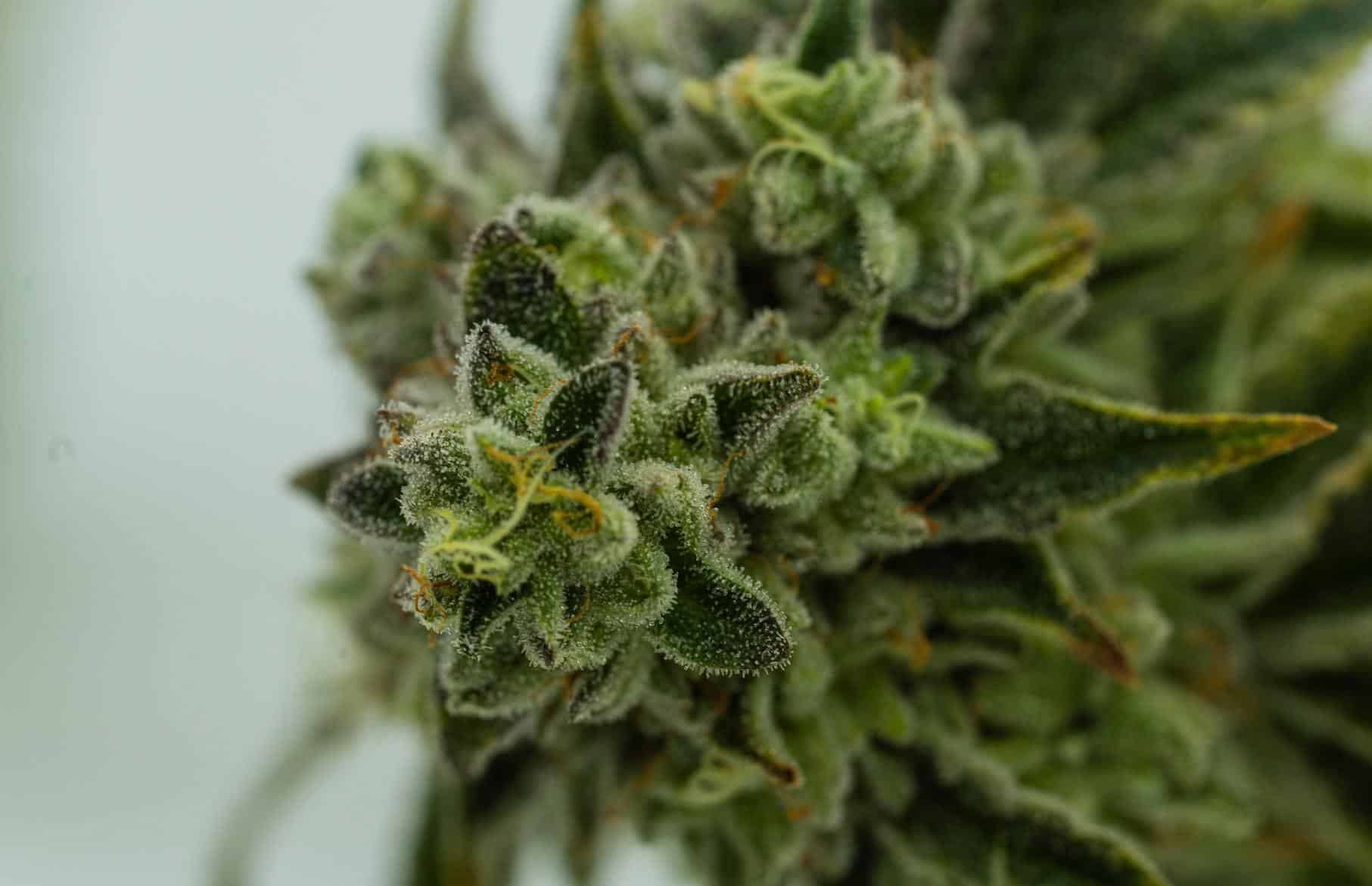






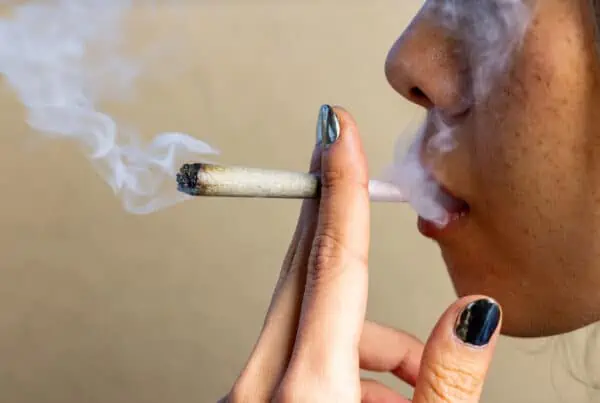
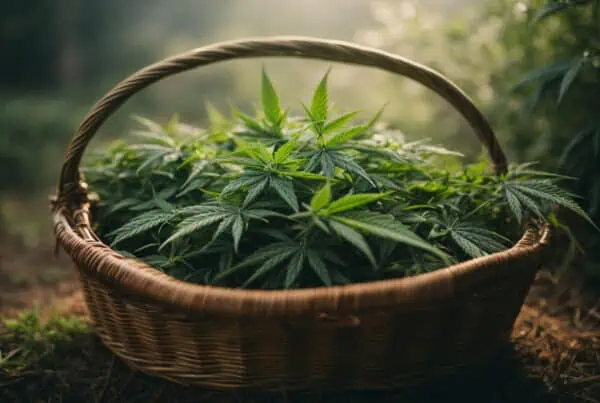

 Jeff was involved in an accident where he endured a traumatic brain injury. He had a week-long stay in ICU where brain surgeons
Jeff was involved in an accident where he endured a traumatic brain injury. He had a week-long stay in ICU where brain surgeons  100% risk free money back guarantee within 48 hours after purchase if student has not completed any of the courses or exams.
100% risk free money back guarantee within 48 hours after purchase if student has not completed any of the courses or exams.